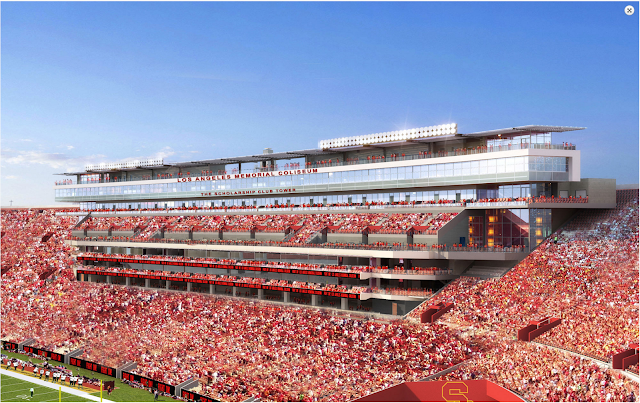Financing the Coliseum Renovation
A frequent topic of conversation at USC games this season has been the school’s plans for renovating the Coliseum. With the athletic department sending out a questionnaire to donors and season ticket holders this past summer, many people have become concerned about the possibility of personal seat licenses (PSL’s) being used to finance the improvements.
USC, under its agreement with the city, county, and state governments, is required to spend at least $70 million on improvements to the Coliseum. However, in looking at other stadiums that have recently been renovated in the PAC-12, it becomes clear that this number will likely be much bigger. The University of Washington spent $280 million for a gut renovation of Husky Stadium that opened last season. The Rose Bowl spent $170 million on renovations that were largely tied to infrastructure and premium seating. The Coliseum is in worse condition than both of these venues were before they began their projects.
In the past decade, college football programs around the country have spent hundreds of millions of dollars to rebuild or renovate their stadiums and facilities. USC faces a unique set of circumstances in that it is 1 of only 12 private schools in the Power 5 conferences. Washington, Alabama, and other public universities have an advantage in financing stadium projects, because they can sell bonds through the state or have the legislature provide funds. Let’s take a look at some financing sources that USC can use to pay for the Coliseum’s improvements:
NAMING RIGHTS
Naming rights can provide a significant amount of money when building new stadiums. The deal for the new Levi’s Stadium in Santa Clara pays the 49ers $220 million over 20 years. It would be extremely ambitious for USC to command that much for naming rights, as the Coliseum is an existing venue that doesn’t host a professional team. However, the university may be able to get $2-4 million a year from a private company. A more likely scenario would be for a donor to give a larger sum upfront to name the field or the stadium itself (ex: Donor Name Field at the Los Angeles Memorial Coliseum). The Galen family donated $50 million to help build USC’s basketball arena. The athletic department may choose to go a similar route and ask for $50-70 million from a single donor in an effort to avoid dealing with private companies.
Total: $30 million to $80 million
| Beautiful, but needs some work. |
PRIVATE DONATIONS
USC is excellent when it comes to fundraising. This would likely involve selling the naming rights to the stadium entrances, the scoreboard, the press box, etc. Given the university’s list of wealthy alumni, it isn’t unrealistic to think they could get $5 million from 20 different donors. However, with the university in the middle of a $6 billion fundraising campaign, they may be a little hesitant to devote fundraising resources towards athletics facilities. Knowing the wealth of the alumni, their love for the football program, and their desire to leave a legacy with the program, this seems like too much of a no-brainer for the athletic department to pass up.
Total: $40 million to $100 million
PERSONAL SEAT LICENSES (PSL’S)
Perhaps the most controversial form of sports fundraising, PSL’s can provide a quick infusion of cash, but can also create ill will among the fan base. USC used PSL’s to help finance the Galen Center, but they struggled to sell, particularly after the basketball program began to perform poorly. In addition, a significant part of USC’s season ticket holders already give over $1,000 a year to the athletic department. I have a feeling that they will use PSL’s for at least the exclusive/premium areas in the stadium. Requiring them for all season tickets would possibly turn the fan base sour and put more pressure on the football program to be consistently successful. If they charged an average of $4,000 for 15,000 seats, it would raise $60 million. If they charged an average of $2,000 for 50,000 seats, it would raise $100 million.
Total: $40 million to $100 million
THE NFL
This is a wildcard, as the NFL may or may not be returning as soon as next year. Any NFL franchise relocating to Los Angeles would need to play 2-4 years in an interim venue (likely the Rose Bowl or Coliseum, but technically Dodger Stadium or Angel Stadium could work too). It is doubtful that the venue would receive anything for rent (maybe $1-3 million per year if they’re lucky), but it is possible that an NFL team would pitch in for a new press box with luxury suites and other minor improvements.
Total: $0 to $10 million
| A rendering from the SCCOG of the Coliseum for the 2024 Olympics. This would be fantastic, but expensive. |
THE OLYMPICS
An even bigger wildcard because Los Angeles seems to be a legitimate candidate, but the host of the 2024 Olympics won’t be decided until 2017, which happens to be around the time that USC plans to start renovations. If LA were to host the 2024 Olympics, the Coliseum would almost certainly be the main Olympic Stadium. This would dramatically alter the scope and needs for the stadium renovation. Presumably, the university is proceeding with the project to meet their needs and not the needs of the Olympic Committee. However, should LA be awarded the Olympics sometime down the road, I would expect a significant contribution from private sources related to the games.
Total: $0 to $100 million



Comments
Post a Comment